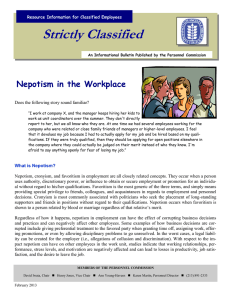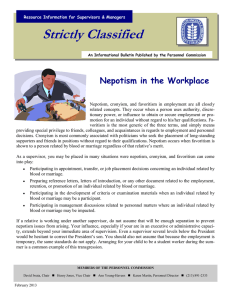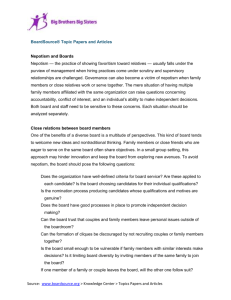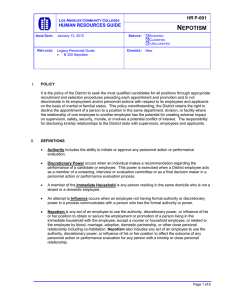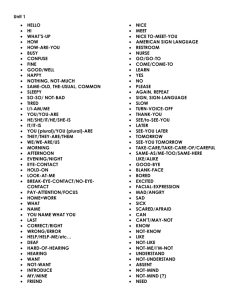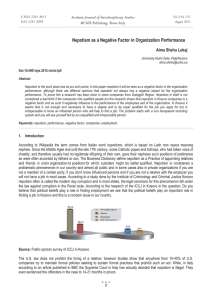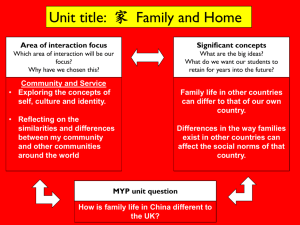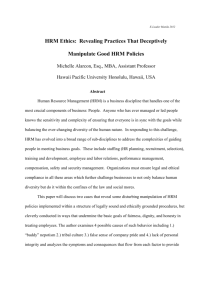here - svencollin.se
advertisement
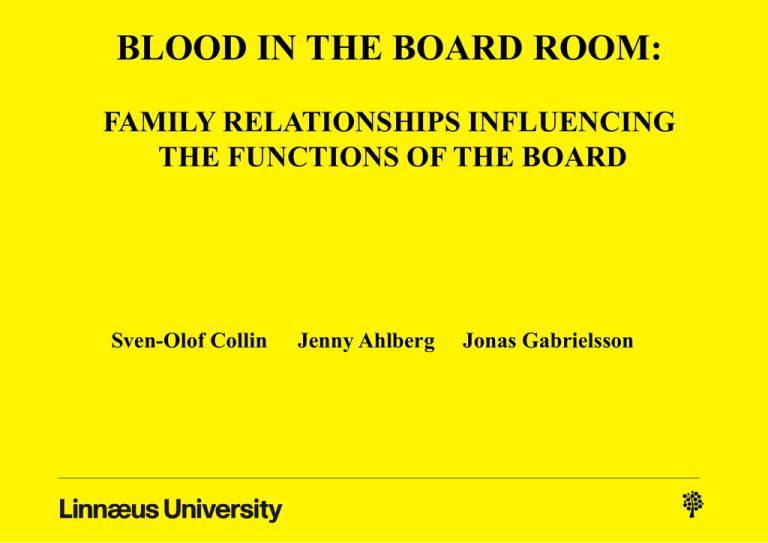
BLOOD IN THE BOARD ROOM: FAMILY RELATIONSHIPS INFLUENCING THE FUNCTIONS OF THE BOARD Sven-Olof Collin Jenny Ahlberg Jonas Gabrielsson Smithsonian firm Marxian firm Family firm “Nepotism is just fine, as long as it is kept within the family” Familiness of the firm Family governance of the firm Ownership structure Board of directors Capital structure Strategy Audit Managerial labor market Structure Do blood relationships at the board influence the functions of the board? Board functions Family Blood, i.e. Nepotism Control Resource provision Decision making Conflict resolution Family and genetics A firm dominated by a family - A firm for a family => family governance and family nepotism Inclusive fitness Genetic relatedness, factor r - 0,5 parent, child, full sibling, dizygotic twin - 0,25 half-sibling, grandparent, grandchild, avuncular relationships - 0,125 cousin, great grandparents, great grandchildren, great aunt/uncle The effect of nepotism Simplifications Nepotism suggested to affect individual and group behavior – genetic relatedness and socialization Silent assumption in family firm research Generation The board Board functions - control - decision making - resource provision - conflict resolution Presence of factor r will influence the orientation towards the four functions as well as the overall activity Family coefficient Hypothesis Control Decision Resource Conflict Activity r=0,5 (sibling, parent) + + r=0,25 (grandparent, uncle) r=0,125 (cousin) + + + + Family coefficient n n - Sample No files of family firms ‘Shotgun’ approach Stepwise surveys First survey: – 14.421 corporations, selected 1.400 corp + 422 corp from a list of gazelle corporations => 1704 corporations – 278 responses (16.3% response rate) Selected family>50% shares AND considered to be family firm by CEO or owner =>148 corporations Second survey = ‘blood survey’ – 68 usable responses, i.e., final response rate = 4% => Explorative study Operationalization Four questions each – Control (alpha=0,61) – Resource (alpha=0,79 – Decision (alpha=0,76) – Conflict (alpha=0,88) – Board activity=Control+Resource+Decision+Conflict r-0,5 share etc = number of r-0.5 relationships/total number of relationships Family coefficient= weighted sum of the r-variable, i.e., ‘blood density’ of the board Numerous control variables: family chair, generation, board size, sales (corp size), industry, solidity, liquidity Results Average 2 family (i.e., genetic) members and 2 non-family members 19% of boards with only family and members through marriage (35% US, 45% Italy, 72% Belgian family firms) Average Control=17,2; Decision=16,7; Resource=15,4 and Conflict=7,6 Chairman of the board from the family=43% r=0,5 (e.g., parent) dominating family relationship Regression results More family, i.e., blood, less control r=0,125 (e.g., cousin) drives conflict emphasis r=0,25 (e.g., grandparent) reduces board activity the most More generations, less conflict Conclusions Exploratory results, no generality test of hypotheses Weak indications of genetic influence on board activity Weak indications of nepotism in r=0.25 (e.g., grandparents) and r=0.125 (e.g., cousin), but not r=0.5 (e.g., parent) , i.e., strongest blood r=0.5 (e.g., parent) includes both blood and socialization through living together => consider Blood and Socialization (interaction frequency etc) Limitation: Gender should be considered Speculation The Battle Ground Board r=0,125 (e.g., cousin) relationships conflict in the extended family with attenuated blood The Training Camp Board r=0.25 (e.g., grandparent) relationships the fifth board function, training camp Blood – what’s the point? - r: a quantitative representation of family relationships - Generation does not represent family relationships - Blood introduces evolutionary psychology The social construction of reality - The natural construction of reality Competitive advantage of family firms? Is it possible to manage nepotism? Is it desirable to manage nepotism?

